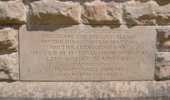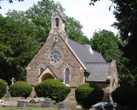For this church:    |
|
 The
foundation stone The
foundation stone |
The foundation stone was laid on the 17th May 1869 by Mrs. Challond on behalf of Lady Louise Beauclerk (first child of the 10th Duke and Duchess Sybil). Matthew Saunders, in his book The Churches of S.S. Teulon, described Emmanuel Church as “The small church which he built 1868-1869 for a wooded site several hundred yards from the house is reticent by comparison although the architect is unmistakable in the perverse rhythm of the fenestrations, the great cusped arch marking the entry into the shallow apse and the pulpit approached by steps set within the wall.”
The vicar was the Rev. George Brown, Rector of Lenton. Bestwood Park was still an outlying portion of the Parish of Lenton.
 Duchess
Sybil’s Duchess
Sybil’smemorial porch |
Duchess Sybil not only executed the five original church windows in the apse, she also embroidered the altar frontals, trained the choir each Wednesday evening in the Lodge and chose the Sunday hymns. She was concerned at the small size of local congregations and anxious to enlarge them. Her death in 1871 led to the addition of a new oversize western porch in her memory with semi-circular mosaic decoration (now destroyed by vandals) beneath the gable.
Pevsner commented that the then Prince of Wales was inspired when he saw Bestwood Lodge to employ Teulon at Sandringham. Of the church he remarks that it is “in Early English style, by Teulon, 1868-9. In the apsidal chancel stained glass by Morris & Co. 1911"
In October 1870 the Duke of St. Albans petitioned Bishop Christopher Wordsworth of Lincoln for a licence to celebrate marriage in the church at Bestwood Park. Nottinghamshire was in Lincoln diocese until 1884. St Albans’ justification was that the population of Lenton Parish was 5,000, the Lenton Parish Church of Holy Trinity was the only Church in the parish licensed for publication of banns and solemnization of marriage and that the Bestwood Church, six miles away, would be convenient to parishioners, especially those in Bestwood Park.
On 24th October 1870 the Bishop granted permission, naming Francis Wright of Osmaston Manor, Derbyshire, the Rev Henry Wright of Standard Hill, Nottingham, Francis Beresford Wright of Aldecar Hall Derbyshire, Fitzherbert Wright of the Hayes, Derbyshire, the Rev Henry Western Plumtree of Eastwood, Nottinghamshire as Patrons, and the Rev George Brown, Vicar of Lenton as a signatory. Letters disclose that fees were paid of two guineas on 10th November 1870 and three guineas on 19th November 1870.
The Church Registers record the first baptism on the 9th October 1870. The first burial was 24th October 1870. The first banns were read on 6th November 1870. The next banns were read in May 1873 for the first marriage, which was performed on 3rd June 1873.
On 11th October 2000 the Queen & Privy Council, under provisions of the Burial Act 1853, ordered that burials be discontinued in Emmanuel Churchyard.
In May 1874 the Ecclesiastical Commissioners granted a stipend of £50 to be paid half yearly on the first of May and September. A letter from Bestwood Park District deposited £50 to the Diocese Registry at Lincoln.
The following month, the Duke of St Albans wrote to the Bishop of Lincoln that “..the Perpetual Curacy of the District of Bestwood Park in the Parish of Lenton and Diocese of Lincoln is now void and doth of right belong to my nomination.” The Ecclesiastical Commissioners certified that the net yearly value of the Perpetual Curacy of the District of Bestwood exceeded the sum of £100 and did not exceed the sum of £150.
The Rev William Richard Cripps was nominated to the Perpetual Curacy of the District of Bestwood Park. His patron was the Duke of St Albans and the referees were:
Francis Morse, Vicar of St Mary’s
Nottingham,
W Vincent Jackson, Vicar of St Stephens,
Nottingham
Edwin Gyles Vicar of All Saints’, Nottingham.
In May 1874 Bishop Wordsworth was petitioned to confirm that the district of Bestwood Park had been constituted, that the Conveyance and consecration of the land for the churchyard and the building and furnishing of the Church had been completed.
An incumbent had been appointed under the Patronage of the Duke, with provision for his stipend. It stated that the land had been voluntarily conveyed by the Duke to the Ecclesiastical Commissioners for ever for the Church and Churchyard and requested that the Bishop be pleased to consecrate them.
On 28th June 1874 the Consecration was performed by the Suffragan Bishop of Nottingham, accompanied by the Rev H T Fletcher, Vicar of Bicker and chaplain to the Duke of St Albans and the Rev R W Cripps.
 The
external turret The
external turretgiving access to the pulpit |
The aisleless nave has painted dado and window heads, and with the apsidal chancel, is under one continuous roof. Access to the pulpit is via a passage and spiral staircase within an outside turret, which has a conical roof.
The domed apse has a matchboard roof with painted roundels probably dating from 1869. On the north wall are two more roundels, probably by the same artist. Above the windows is the following text
| O ALL YE WORKS OF THE LORD BLESS YE THE LORD PRAISE HIM AND MAGNIFY HIM FOR EVER |
In 1907 plaster in the wall of the apse was cut away and stone arcading with marble columns installed. The panels within the arcading at the base of the apse are painted and enriched with decorations of stencilled flowers, religious and possibly Masonic symbols.
The credence slab was removed and replaced by an oak credence table.
At the east end of the Church are five stained glass memorial windows by William Morris & Co. The wall between each window is adorned with painted and gilded lilies and pomegranates.
The west end of the church is dominated by the memorial to Sybil the first wife of the 10th Duke of St Albans with memorial windows, a marble plaque and raised bust of Sybil sculpted by Princess Louise.
The 1930 correspondence between the Diocese of Southwell and solicitors Thurgood, Martin and Trumper of Chancery Lane, London reveal that the Bestwood Coal and Iron Company withdrew their grant of £150 a year leaving the Incumbent in a perilous financial position at a time when the 11th Duke’s estate was under the control of the Lunacy Commissioners. A temporary grant of £47 per annum was made out of the common Fund.
The 11th Duke died in 1934. In 1938 the 12th Duke sold Bestwood Lodge to pay Death Duties. Almost immediately, the Lodge was requisitioned by the Army for the duration of the Second World War. In 1952 the Ministry of Defence purchased the Lodge, which became the Army’s North District Headquarters occupied by the Royal Army Pay Corps until 1977.
The Rev William Walker, retired, former Vicar of St Paul’s Daybrook, was also Chaplain to the Army at Bestwood Lodge. Father Walker recollects that the chapel within the Lodge was used for services for other ranks and, as well as being a parish church, Emmanuel Church was used by the Officers. He recalls that better attendance was achieved when the General was in church.
In May 1969 the church celebrated its centenary. The Rev John Davies, Assistant Chaplain, General Northern Command preached at a special service and there was a garden party for the joint churches of Bestwood and Daybrook in the grounds of Bestwood Lodge. A working party of parishioners had cleared the churchyard, still surrounded by fields and woods, of brambles and undergrowth for the celebration.
On Sunday 16th September 1984 the Bishop of Southwell inaugurated the Ecumenical Parish of Bestwood. To commemorate the event, on the North side of the Nave is a framed document signed by one Churchwarden from each of the six Churches incorporated into a new Ecumenical parish.
The Ecumenical Parish of Bestwood  Believing in the call and grace 
|
On the north side of the church the present vicarage and church hall on Church View Close were constructed in 1980.
There has been some restoration work in recent years. The stone work for the arcading was carried out in 2004 by N. M. Douglas of Lowdham. The stone was replaced with Bath Stone and the marble pillars were refurbished and the stone bonded together with epoxy resin, not Plaster of Paris as originally used. In June 2004 the Arcading paintings were restored by Donald Smith whose business is based in Dorset. Casein is the binding agent used. The paint is water-based, the colours he mixes with his own pigments, are built up in layers to cover the different textures of the base surface. This material is breathable and is used because of the damp. Gold leaf was used for the banding around the inside of the arcading. The Archdeacon of Nottingham, the Ven Gordon Ogilvie, led a service of dedication on 11 July 2004.
Sunday 15 February 2004 was Beverley Stark’s last service at Emmanuel. She had been vicar since 1997 and had driven the church forward and had seen much restoration work completed.
On 18 July 2004 Dave Gray, Curate, led his last service at Emmanuel before moving to St John’s, Bulwell.
On 12 April 2005 the new vicar, the Rev. Peter Huxtable, was inducted in the parish at St Marks, Bestwood.
In November/December 2005 the inside of the apsidal east end was cleaned and renovated and the two angels playing musical instruments on the north side of the chancel renovated and re-painted by Donald Smith.
The Lych gate was moved from the south-east corner of the churchyard to the west end of the churchyard in 2009.
In February 2010 the Revd. Peter Huxtable left Bestwood.
The Revd. Elizabeth Snowden arrived at Bestwood in October 2010.
In November 2014 the Revd. Chrissie Little joined the Bestwood parish.
The pews were removed in February 2015 and replaced by padded chairs.
The Revd. Elizabeth Snowden left Bestwood in February 2016.
In October 2017 the Bestwood parish is still without a vicar; the Revd Chrissie Little, associate Priest, is temporarily in charge.
St Mark’s Church
The Duke of St. Albans had interests in the Bestwood Coal and Iron Company, formed in August 1872. To accommodate his workers he built Bestwood village. In 1886, ten years after building the village’s first row of houses, St Mark’s Church was constructed as a mission church and a daughter church of Emmanuel Bestwood.
The parsonage was built on a portion of a plantation on the road from Bestwood Lodge to Bestwood Colliery. The land for the parsonage, one and a quarter acres and worth £250, was donated by the Duke of St. Albans. Correspondence from the Ecclesiastical Commissioners, connected with the conveyance in 1888, expresses concern that the Duke retained the mineral rights under the land. The Commissioners were reassured that mining would not put the property at risk.
On the 2nd August 1888 a grant was made by the Ecclesiastical Commissioners in augmentation of the living, with a Capital sum of £950 to meet certain benefactions.






